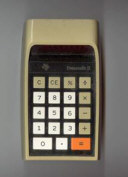
DATAMATH CALCULATOR MUSEUM
 |
DATAMATH CALCULATOR MUSEUM |
The company is born May 16, 1930 in the wildcat oil days in Texas. John Clarence
"Doc" Karcher and Eugene McDermott start Geophysical Service, using seismology to find oil. The company begins with 12 exploration
crews living a nomadic life in the oilpatch. In the '40s, new owners and a new direction shape the future. The
day before Pearl Harbor, Eugene McDermott, Cecil Green, Erik Jonsson and H.B. Peacock buy Geophysical Service Inc. (GSI).
The company begins to branch out from oil exploration by producing
submarine detection devices for the U.S. government as part of the World War II
effort. In 1951 the name of the company was changed to Texas Instruments Incorporated (TI).
One year later TI purchased from Western Electric Company the license to produce
transistors.
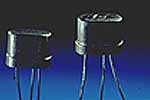 On May 10, 1954 Texas Instruments announced a
revolutionary new electronic product, the silicon transistor. Searching for a
killer application, TI developed the first commercial available miniaturized
transistor radio marketed as the Regency
TR1. Read the press release, dated October 18, 1954.
On May 10, 1954 Texas Instruments announced a
revolutionary new electronic product, the silicon transistor. Searching for a
killer application, TI developed the first commercial available miniaturized
transistor radio marketed as the Regency
TR1. Read the press release, dated October 18, 1954.
TI's part in the production of the first commercial
transistorized radio receiver will be announced beginning today in newspapers
throughout the country.
The "pocket size" radio has four TI transistors. It also uses a TI
subminiature output transformer. The transistors - technically known as n-p-n grown junction
germanium triodes - are made in the Semiconductor Products Division. The transformer is a product of the Components Division.
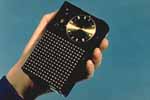 Their application to the new radio receiver accounts for a large part
of the increased production and employment in the two divisions in recent weeks. The Apparatus Division has also had a hand in the
tiny radio, having worked on engineering problems and the machining and fabricating of models for the plastic case.
Their application to the new radio receiver accounts for a large part
of the increased production and employment in the two divisions in recent weeks. The Apparatus Division has also had a hand in the
tiny radio, having worked on engineering problems and the machining and fabricating of models for the plastic case.
The receiver is being assembled and marketed by the Regency
Division of Industrial Development Engineering Associates, Inc., Indianapolis. It will be available this week to the public through sales
outlets in Los Angeles and New York City. When production permits, it will be sold in cities throughout the
country. For competitive reasons it was decided to keep the development of the
radio, including TI's part in it, "under wraps" until the unit was ready for marketing.
The radio receiver measures 5 x 3 x 1 1/4 inches - the smallest set
commercially available - with the semiconductor devices themselves occupying less than 1/10 of a cubic inch. The "pocket size" is a
significant achievement since it includes a high fidelity, high volume speaker and a single battery supply as well as all associated
receiver circuit components.
Gain at radio frequency with the germanium transistor is sufficient
to permit a combined mixer-oscillator stage. Only two intermediate frequency stages are required and, following a germanium diode
detector, one audio amplifier stage. Audio volume fidelity and reception range are the equal of or superior to that of the small
vacuum tube-equipped portable radios.
The introduction of this first mass production item to use the tiny
transistor to replace the fragile vacuum tube leads the way for the long-predicted transistorization and miniaturization of many other
mass production consumer devices. TIers can justly be proud of being the first to produce a high-gain transistor at a cost permitting
its application to the high-volume commercial market.
It was a relatively simple device that Jack Kilby showed to a handful of co-workers gathered in TI's semiconductor lab almost 40 years ago -- only a transistor and other components on a slice of germanium. Little did this group of onlookers know, but Kilby's invention, 7/16-by-1/16-inches in size and called an integrated circuit, was about to revolutionize the electronics industry.
It was in a deserted laboratory at TI's brand new Semiconductor
Building where Jack Kilby first hit on the idea of the integrated circuit. In July 1958, when everyone else left for the traditional
two-week vacation period, Kilby stayed to man the shop.
What caused Kilby to think along the lines that eventually resulted in the integrated circuit? Like many
inventors, he set out to solve a problem. In this case, the problem was called "the tyranny of
numbers." For almost 50 years after the turn of the 20th century, the electronics industry had been dominated by vacuum tube
technology. But vacuum tubes had inherent limitations. They were fragile, bulky,
unreliable, power hungry, and produced considerable heat.
It wasn't until 1947, with the invention of the transistor by Bell Telephone Laboratories, that the vacuum tube problem was
solved. Transistors were miniscule in comparison, more reliable, longer lasting, produced less heat, and consumed less power. The
transistor stimulated engineers to design ever more complex electronic circuits and equipment containing hundreds or thousands
of discrete components such as transistors, diodes, rectifiers and capacitors. But the problem was that these components still had to
be interconnected to form electronic circuits, and hand-soldering thousands of components to thousands of bits of wire was
expensive and time-consuming. It was also unreliable; every soldered joint was a potential source of trouble. The challenge was
to find cost-effective, reliable ways of producing these components and interconnecting them.
One stab at a solution was the Micro-Module program sponsored
by the U.S. Army Signal Corps. The idea was to make all the components a uniform size and shape, with the wiring built into the
components. The modules then could be snapped together to make circuits, eliminating the need for wiring the
connections.
TI was working on the Micro-Module program when Kilby joined
the company in 1958. Because of his work with Centralab in Milwaukee, Kilby was familiar with the "tyranny of
numbers" problem facing the industry. But he didn't think the Micro-Module was the answer it didn't address the basic problem of large
quantities of components in elaborate circuits.
So Kilby began searching for an alternative, and in the process
decided the only thing a semiconductor house could make cost effectively was a semiconductor. "Further thought led me to the
conclusion that semiconductors were all that were really required that resistors and capacitors [passive devices], in
particular, could be made from the same material as the active devices [transistors]. I also realized that, since all of the components could
be made of a single material, they could also be made in situ interconnected to form a complete circuit," Kilby wrote in a 1976
article titled "Invention of the IC."
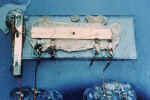 Kilby began to write down and sketch out his ideas in July of 1958. By September, he was ready to demonstrate a working
integrated circuit built on a piece of semiconductor material. Several executives, including former TI Chairman Mark
Shepherd, gathered for the event on September 12, 1958. What they saw was a sliver of germanium, with protruding wires, glued to a glass
slide. It was a rough device, but when Kilby pressed the switch, an unending sine curve undulated across the oscilloscope
screen. His invention worked he had solved the problem.
Kilby began to write down and sketch out his ideas in July of 1958. By September, he was ready to demonstrate a working
integrated circuit built on a piece of semiconductor material. Several executives, including former TI Chairman Mark
Shepherd, gathered for the event on September 12, 1958. What they saw was a sliver of germanium, with protruding wires, glued to a glass
slide. It was a rough device, but when Kilby pressed the switch, an unending sine curve undulated across the oscilloscope
screen. His invention worked he had solved the problem.
Kilby had made a big breakthrough. But while the U.S. Air Force
showed some interest in TI's integrated circuit, industry reacted skeptically. Indeed the IC and its relative merits "provided much of
the entertainment at major technical meetings over the next few years," Kilby
wrote.
The integrated circuit (SN502 Solid Circuit Flip Flop -
March, 1960. Initial price $450 ) first won a place in the military market
through programs such as the first computer using silicon chips for the Air Force in 1961 and the
Minuteman Missile in 1962. Recognizing the need for a "demonstration
product" to speed widespread use of the IC, Patrick E.
Haggerty, former TI Chairman, challenged Kilby to design a calculator as powerful as
the large, electro-mechanical desktop models of the day, but small enough to fit in a coat pocket. The resulting electronic hand-held
calculator, of which Kilby is a co-inventor, successfully commercialized the integrated
circuit.
Texas Instruments Incorporates. Dallas (September 9,
1997)
The program that resulted in the development of the hand-held
calculator grew out of a September 1965 conversation between Jack S. Kilby, then a lab director at the Dallas headquarters of
Texas Instruments, and two of his colleagues, Jerry D. Merryman
and James H. Van Tassel. Kilby had invented the integrated circuit
(IC) at TI in 1958, and he and the company share a natural interest in demonstrating how the devices could be used and in
broadening the market for them.
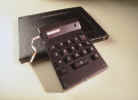 The three engineers envisioned building an
IC-based, battery-powered "miniature calculator" that could add, subtract, multiply and divide, yet could fit in the palm of the hand. A year
earlier a Japanese firm had introduced the first all-transistor desktop
calculator; it weighed 55 pounds and cost $2500.
The three engineers envisioned building an
IC-based, battery-powered "miniature calculator" that could add, subtract, multiply and divide, yet could fit in the palm of the hand. A year
earlier a Japanese firm had introduced the first all-transistor desktop
calculator; it weighed 55 pounds and cost $2500.
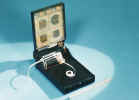 After two years of development, the three TIers completed the
first hand-held calculator in 1967. The battery-powered device could accept six-digit numbers, perform the four basic arithmetic
functions, and print results as large as 12 digits on a thermal printer. The calculator had a case fashioned from a solid piece of
aluminum; it measure about 4-1/4 by 6-1/8 by 1-3/4 inches and weighed 45 ounces.
The model was not mass-produced immediately.
After two years of development, the three TIers completed the
first hand-held calculator in 1967. The battery-powered device could accept six-digit numbers, perform the four basic arithmetic
functions, and print results as large as 12 digits on a thermal printer. The calculator had a case fashioned from a solid piece of
aluminum; it measure about 4-1/4 by 6-1/8 by 1-3/4 inches and weighed 45 ounces.
The model was not mass-produced immediately.
 Texas Instruments approached Canon Inc. (Tokyo) and arranged to coproduce a pocket
calculator completely built with Texas Instruments parts.
In April 1970, the Pocketronic appeared on the Japanese market; it was a four-function, entirely
electronic calculator that retailed for about $400. The machine was marketed in the United States in the fall of that
year. The Pocketronic was in one line with other battery operated calculators
like the
Busicom LE-120, Sanyo ICC-82D and Sharp EL-8.
(Read more about Sharp company here.)
Texas Instruments approached Canon Inc. (Tokyo) and arranged to coproduce a pocket
calculator completely built with Texas Instruments parts.
In April 1970, the Pocketronic appeared on the Japanese market; it was a four-function, entirely
electronic calculator that retailed for about $400. The machine was marketed in the United States in the fall of that
year. The Pocketronic was in one line with other battery operated calculators
like the
Busicom LE-120, Sanyo ICC-82D and Sharp EL-8.
(Read more about Sharp company here.)
The inventors filed a U.S. patent application later in 1967, and the U.S. Patent Office issued patent number 3,819,921 on June 25, 1974. On December 4, 1975, the Smithsonian Institution accepted TI's donation of the prototype device for its permanent collection.
Don't miss TI's press
release dated August 15, 2002 to celebrate the 35th anniversary of its
invention of the electronic calculator.
 The "calculator-on-a-chip" was an MOS integrated circuit announced
The "calculator-on-a-chip" was an MOS integrated circuit announced
This single chip may make full electronic calculators available to everyone at prices that can
put a calculator into every kitchen or businessman's pocket. The chip incorporates all of the logic and memory circuits to perform
complete 8-digit 3-register calculator functions, including full precision add,
subtract, multiply, and divide operations.
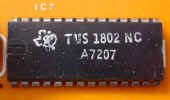 Designated the
TMS1802NC, the "calculator-on-a-chip" is available
for immediate delivery and is priced at less than $20 in large quantities. The unit announced today provides an accounting type
of keyboard entry. Later this year, a formula keyboard entry model will be introduced.
Designated the
TMS1802NC, the "calculator-on-a-chip" is available
for immediate delivery and is priced at less than $20 in large quantities. The unit announced today provides an accounting type
of keyboard entry. Later this year, a formula keyboard entry model will be introduced.
Packaged in a 28-pin plastic dual-in-line package, the TMS1802NC provides the following calculator features: 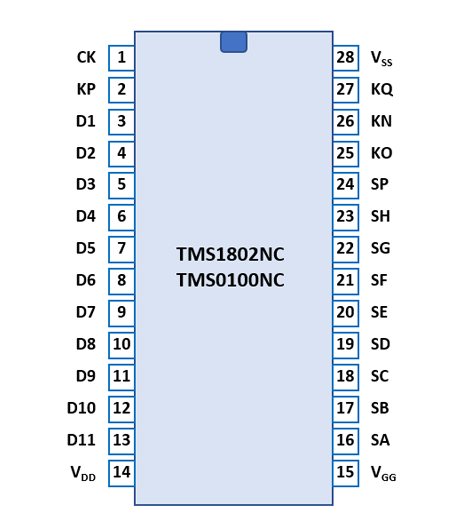
|
Eight Digits Four Operations Three Registers Floating-point or Fixed-point Operation (8 positions) Constant or Chain Operation Automatic Roundoff Overflow Most Significant Digit Protection Leading-zero Suppression Internal Encoding of Keyboard Inputs Decoded Display Outputs Single-phase Clock Automatic Power-up Clear |
The TMS1802 has been designed to operate with very few
external components. A simple switch matrix keyboard can be used, because encoding and debouncing are performed on the
chip. This calculator chip has been designed to be used with most popular segmented displays. The display outputs are fully
decoded, including inter-digit blanking and leading-zero suppression. Only simple buffers are needed to drive most
numerical displays currently available. The TMS1802 has also been designed to operate with simple seven- or eight-segment
visible light-emitting diodes or liquid-crystal optoelectronic displays.
The basic calculator logic unit consists of a 3,520 Bits Read-only program Memory (ROM, 320 Words x 11 Bits), a 182-bit Serial-access Memory (SAM, 3 Registers * 13 Digits, 2 * 13 Bit-Flags); and a decimal arithmetic logic unit as well as control, timing, and output
decoders. The calculator circuit is implemented on a single 230 by 230 mil chip of silicon which is mass produced using the standard
silicon nitride MOS process. Functional variations of the standard calculator chip are easily made, because the entire circuit has been
designed using TI programmable logic array (PLA) techniques. Functional variations of the basic circuit can be made by changing
a single photo mask in the manufacturing process.
Architecture of the calculator chip is such that the basic chip can
host most calculator computing functions requiring up to 8-digit characteristics. The device is totally programmable, the
"program" read-only memory, timing sections, control section and input/output decoders can be programmed to achieve different
computing characteristics. This approach offers maximum design flexibility at very low cost.
It is important to understand that the TMS1802 is a specific
implementation of a basic or host calculator logic chip. Any number of special operational characteristics can be easily
implemented by TI using single-level mask programming techniques of the same basic or host design. The only limitations
are the size of the program ROM, the RAM storage, and the control, timing, and output decoders. For example, by
reprogramming the output decoders the TMS1802 can be used to drive decimal displays such as Nixie type tubes.
It is also expected that the ease of program variations will make
the basic calculator logic chip suitable for many other non-calculator applications such as
meters, registers, terminals, controls, and logic elements. Typical meter applications may
include clocks, scales, utility, speed event, and digital volt meters.
In a 28-pin plastic dual-in-line package, the 8-digit TMS1802NC
calculator circuit is priced as follows F.O.B. U.S.A:
| Unit | 1-24 | 24-99 | 100-249 |
| TMS1802NC | $150 | $125 | $95 |
The unit is immediately available in distribution quantities. Production quantities are available in six weeks after receipt of order.
Texas Instruments Incorporates. Dallas, Texas
The chip provided the equivalent of some 5000 transistors. Changing a single photo mask permitted functional variations, including slide rule type calculations as well. Patent No. 4074351 was issued in July, 1971, to Gary Boon and Michael J. Cochran and assigned to TI. The TMS1802 was later renamed to TMS0102, the basic chip design was known as the TMS100 or TMS0100. Variations were made to fit individual calculator requirements for outside customers as well as Texas Instruments. About 25 years later the US Patent Office officially recognize Gary Boone and TI as the inventor of the single-chip microcontroller. More about the TMS0100 can be found here.
The Minimath was the first calculator designed by Texas Instruments for production. After
evaluation of a limited production quantity, it was decided not to place it in production. The Minimath uses the TMS0111 variation of the TMS0100 design.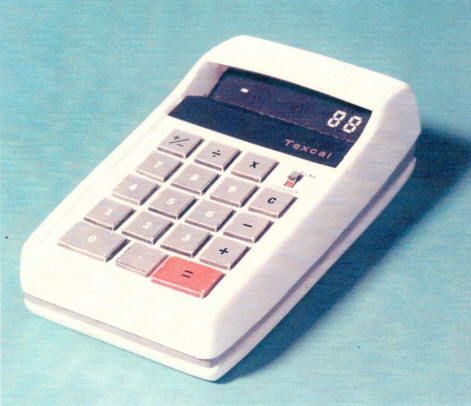 Think
about the "soap-box" design of the first US-built calculator
Bowmar
901B introduced September 1971 and you understand the thoughts of the
marketing department of Texas Instruments. The man behind the wonderful Datamath
and the related Desktop models TI-3000 / TI-3500, Fred M. Gore of Fred Gore
& Associates, Inc. consulting industrial designers of Carrollton, Texas
remembers like yesterday: "The marketing criterion required the cases be
aesthetically appealing to Male & Female engineers, architects, artists and
anyone using calculators. Also the Datamath case dimensions had to fit into any
man's shirt pocket and I have yet to find a typical shirt pocket in which it
will not fit. When removing the Datamath from my shirt pocket, a crowd of people
would want to know where they could buy one. It's dimensional size were
revolutionary to any calculator on the market at that time. Of course
calculators have come a long way in miniaturization of cases."
Think
about the "soap-box" design of the first US-built calculator
Bowmar
901B introduced September 1971 and you understand the thoughts of the
marketing department of Texas Instruments. The man behind the wonderful Datamath
and the related Desktop models TI-3000 / TI-3500, Fred M. Gore of Fred Gore
& Associates, Inc. consulting industrial designers of Carrollton, Texas
remembers like yesterday: "The marketing criterion required the cases be
aesthetically appealing to Male & Female engineers, architects, artists and
anyone using calculators. Also the Datamath case dimensions had to fit into any
man's shirt pocket and I have yet to find a typical shirt pocket in which it
will not fit. When removing the Datamath from my shirt pocket, a crowd of people
would want to know where they could buy one. It's dimensional size were
revolutionary to any calculator on the market at that time. Of course
calculators have come a long way in miniaturization of cases."
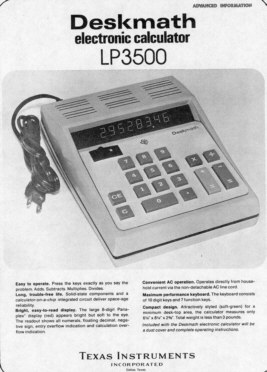 The
development of both the TI-2500
and the desktop models TI-3000/TI-3500
was done parallel. The design, the internal construction and other details are
similar. Remarkable that even the nicknames of the calculators kept similar
until the final introduction of the products. The picture on the right is titled
"ADVANCED INFORMATION" and announced the Deskmath calculator LP3500.
Even on the key plate you'll find the name Deskmath printed to give the
association to the Datamath, the portable sibbling with the official model
designation TI-2500. Well, history told us that the calculator was introduced in
a First Series as LP3000 before the
TI-3000 with a slightly darker housing appeared on the market.
The
development of both the TI-2500
and the desktop models TI-3000/TI-3500
was done parallel. The design, the internal construction and other details are
similar. Remarkable that even the nicknames of the calculators kept similar
until the final introduction of the products. The picture on the right is titled
"ADVANCED INFORMATION" and announced the Deskmath calculator LP3500.
Even on the key plate you'll find the name Deskmath printed to give the
association to the Datamath, the portable sibbling with the official model
designation TI-2500. Well, history told us that the calculator was introduced in
a First Series as LP3000 before the
TI-3000 with a slightly darker housing appeared on the market.
Please notice that the pictured LP3500 sports both an 8-digit display instead the 10-digits of the real TI-3500 calculator and a nice keyplate never found on the market.
Some decades after the introduction we will smile reading the topics of this announcement:
Easy to operate. Press the keys exactly as
you say the problem. Adds. Subtracts. Multiplies. Divides.
Long, trouble-free life. Solid-state components and a calculator-on-a-chip
integrated circuit deliver space-age reliability.
Bright, easy-to-read display. The large 8-digit Panaplex display (red)
appears bright but soft to the eye. The readout shows all numerals, floating
decimal, negative sign, entry overflow indication and calculation overflow
indication.
Convenient AC operation. Operates directly from household current via the
non-detachable AC line cord.
Maximum performance keyboard. The keyboard consists of 10 digit keys and
7 function keys.
Compact design. Attractively styled (soft-green) for a minimum desk-top
area, the calculator measures only 6Ό" * 8Ό" * 2Ό". Total
weight is less than 3 pounds.
Texas Instruments Incorporates. Dallas,
Texas
The official introduction of the TI-2500 Datamath portable calculator and the desktop models TI-3000 and TI-3500 dates back to September 21, 1972. Please find a reprint of the text published by Texas Instruments, Dallas, TX and additional picture provided by Fred M. Gore, Carrollton, TX.
Texas Instruments Enters Calculator Market With
Three New Electronic Calculators
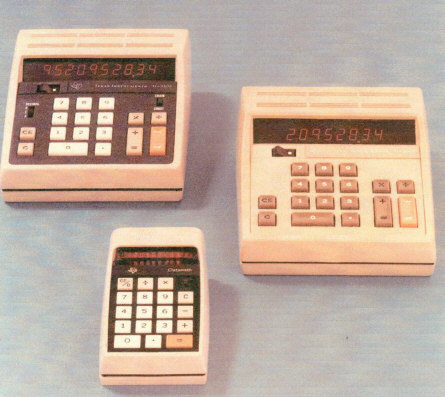 A line of three new calculators introduced today marks the formal
entry of Texas Instruments into the electronic calculator market. The three new calculators are the TI-2500 portable calculator and
the TI-3000 and TI-3500 desk models.
A line of three new calculators introduced today marks the formal
entry of Texas Instruments into the electronic calculator market. The three new calculators are the TI-2500 portable calculator and
the TI-3000 and TI-3500 desk models.
Commenting on TI's entry into the calculator business Jay Rodney
Reese, Vice President and Manager of the company's Solid State Products Division, stated, "Our company is dedicated to the belief
that electronics will pervade all segments of our society. As electronics continues to open up new markets, Texas Instruments
will analyze these high growth opportunities to determine if our company can make a real contribution to society. We believe that
an exceptionally good match between the needs of the market and
our technological and manufacturing capabilities exists in the electronic calculator field."
The TI-2500 portable electronic calculator is a
four-function, full-floating-decimal-point unit with an eight-digit light-emitting-diode display. With a suggested retail price of under
$120, the TI-2500 calculator is rechargeable and capable of portable or ac operation. The TI-2500 unit uses algebraic entry -
ideal for general public use.
The TI-3000 and TI-3500 desk electronic calculators have
suggested retail prices of under $85 and under $100, respectively. Both of these calculators are four-function units with gas-discharge
displays, and both use formula entry - the same as standard business machines. The TI-3000 is an eight-digit unit and has a
fully floating decimal point. The TI-3500 calculator uses a ten-digit display and can be operated with either a fully floating decimal
point or the decimal can be preset at either the second or fourth position.
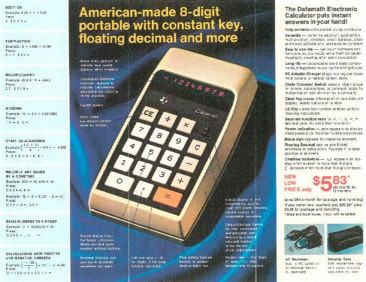 Built entirely of American-made components, most of them
produced by Texas Instruments, the calculators are manufactured in TI's Dallas facility. The heart of the calculators, the
MOS/LSI calculator-on-a-chip, is produced in TI's plant in Houston, Texas. The keyboards come from the TI facility in
Attleboro, Mass.; while the plastic cases are molded in the company's Sherman, Texas location. The light-emitting-diode (LED) displays used in
the TI-2500 calculator are produced by TI's optoelectronics department in Dallas.
Built entirely of American-made components, most of them
produced by Texas Instruments, the calculators are manufactured in TI's Dallas facility. The heart of the calculators, the
MOS/LSI calculator-on-a-chip, is produced in TI's plant in Houston, Texas. The keyboards come from the TI facility in
Attleboro, Mass.; while the plastic cases are molded in the company's Sherman, Texas location. The light-emitting-diode (LED) displays used in
the TI-2500 calculator are produced by TI's optoelectronics department in Dallas.
TI-2500 Portable Electronic Calculator
The TI-2500 electronic calculator performs addition,
subtraction, multiplication, and division. For a credit balance, a minus sign appears on the display to indicate the true value of the negative
results. The unit utilizes full-floating-decimal-point operation. The TI-2500 can perform both chain and mixed calculations or utilize a
stored constant for either multiplication or division. Solid-state components, integrated circuits, and a display using
light-emitting diodes provide dependable operation and long life. Extensively test-marketed under the "Datamath" designation, the
TI-2500 was well received by both end users and retailers. One retailer has been quoted as having had a defective rate of only one
percent with the TI-2500 as compared to a store average of ten percent.
As it was designed for general use, the TI-2500 calculator uses
what is termed algebraic entry. The user presses the keys exactly as he would say the problem (A + B - C =). Negative values are
assigned by pressing the - key before entering the value of the negative number. Negative calculation results are displayed with a
minus sign and their true negative value (-14.63 rather than 999985.37).
Fully portable, the TI-2500 electronic calculator is 5.5 by 3.0 by
1.7 inches in size and weighs only 12 ounces. The unit contains a rechargeable power pack that delivers at least 4 1/2 hours of
continuous calculation before requiring recharge. The adapter/charger included with the TI-2500 calculator will recharge
the calculator from normal house current overnight. The calculator can be used while being recharged. In fact, the calculator can be
used indefinitely while connected to the adapter/charger as the batteries cannot be overcharged.
The 8-digit light-emitting-diode readout is designed to be clearly
visible during either hand-held or desk-top operation. The readout shows up to eight numbers, floating decimal point (at any of eight
locations), and a minus sign as well as an indication of entry overflow or calculation overflow. A low battery condition is
indicated by activation of all eight decimal points.
To conserve battery power during interrupted operation (such as
when the user answers a telephone), all the display except for the character in the number one position turns off approximately 15
seconds after the last key is pressed. This standby mode conserves power during non-use. If the display turns off while
entering a problem, the display will turn on automatically with the first keyboard entry. The last calculated result can be restored to
the display by pressing the CE/D key.
The low profile keyboard consists of 10 number keys (0 through
9) and 8 function keys. The function keys consist of: + (plus), - (minus), x (multiply), (divide), = (equals), . (decimal point), C
(clear), and CE/D (clear entry/display). All keys are single function except the CE/D key which is used both to clear the last input in
case of error and to restore the display after automatic turn-off.
A chain/constant switch located on the keyboard selects either
CHAIN mode for normal calculations or CONSTANT mode for convenient multiplication or division by a constant. In the CHAIN
mode, the last calculation result is always available for further calculations; it does not have to be re-entered before
adding, subtracting, multiplying, or dividing by another number. Entry of another number before pressing the +, -, x, or divide
keys, however, automatically clears the previous calculation result. There is no
need to clear the memory for each calculation.
In the CONSTANT mode, the constant to be used is entered
after the x or divide function and directly before the = key is depressed. Subsequent calculations are performed simply by
entering the number to be multiplied or divided by the constant and then pressing the = key. This stored constant can be erased either
by subsequently entering another constant or by pressing the C key.
TI-3000 Desk Electronic Calculator
Designed for both home and office use, the new Texas Instruments
TI-3000 desk electronic calculator has a suggested retail price of under $85. An attractive desk calculator, the TI-3000 is light
enough (less than 30 ounces) to conveniently carry in a small briefcase. The calculator operates directly from standard house
current through a nondetachable plug-in cord.
The unit has complete four-function capability (add,
subtract, multiply, and divide) and fully floating decimal point. The large eight-digit gas-discharge display is clearly visible for desk-top
use. The display shows all numbers, floating decimal point, negative sign, plus entry and calculation overflow indications.
The keyboard consists of an on-off switch, 10 digit keys (0
through 9), and 7 function keys (plus-equals, minus-equals, times, divide, decimal, clear, and clear entry). Easy to read and easy to
operate, the keys are located for maximum performance. Standard key arrangement permits solving complex problems
without looking at the keyboard. The TI-3000 uses formula entry - the same as standard business machines. Thus, personnel familiar
with older mechanical calculators will have no difficulty switching over to the new TI-3000 calculator.
TI-3500 Desk Electronic Calculator
With a suggested retail price of under $100, the TI-3500 desk
electronic calculator is a step-up model designed primarily for business or home office use. In addition to the features of the
TI-3000, the TI-3500 has the chain/constant feature (also offered on the TI-2500) as well as a choice of a completely floating
decimal point or presetting the decimal at either the second or fourth decimal position. Also, the TI-3500 has a ten-digit
gas-discharge display instead of the eight-digit one for the TI-3000.
Price and Availability
Suggested retail prices of the TI-2500, TI-3000, and TI-3500
electronic calculators are $119.95, $84.95, and $99.95, respectively. All of these calculators are shipped to dealers in
boxes of six units each and have a minimum dealer order of 96 units. The TI-2500 and TI-3000 calculators are available for
immediate shipment; the TI-3500 calculator will be available in mid-October.
Special thanks to the designer of the wonderful Datamath calculator, Fred M. Gore of Fred Gore & Associates, Inc. consulting industrial designers of Carrollton, Texas. Member of the Industrial Designers Society of America.
Datamath is a trademark of Texas Instruments.
If you have additions to the above article please email: joerg@datamath.org.
© Joerg Woerner, November 16, 2001. No reprints without written permission.